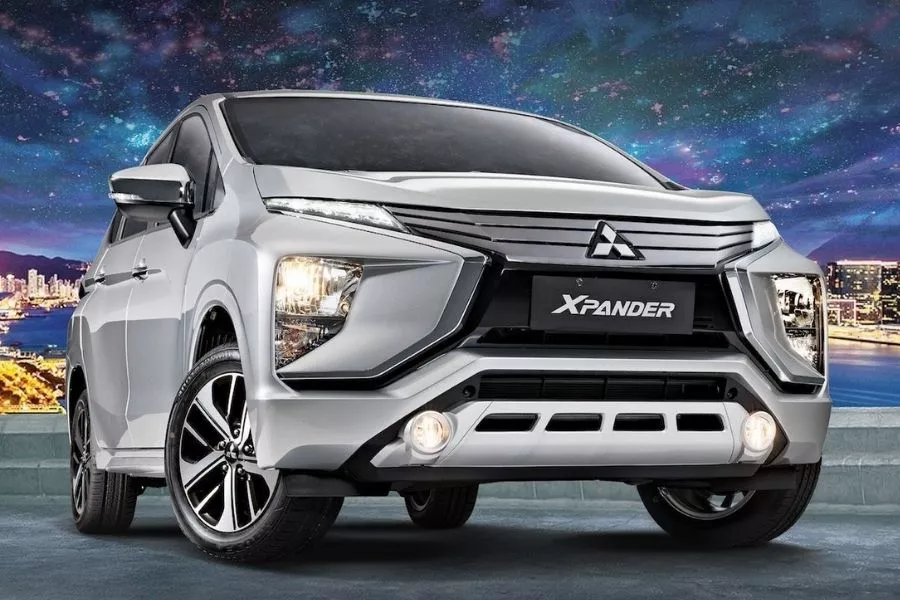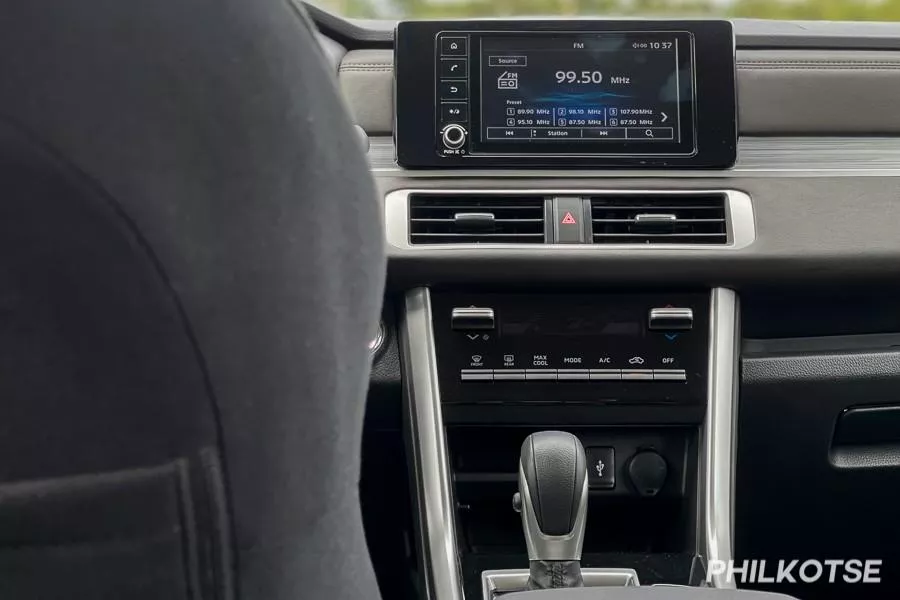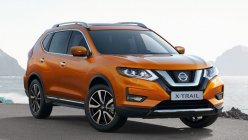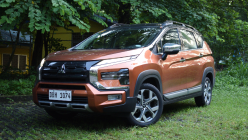Launched in the Philippines back in 2018, the Mitsubishi Xpander has since become a household name when it comes to seven-seater compact MPVs. Its sleek, modern looks and roomy interior has captured a lot of attention. Currently, it’s one of the desirable family cars with a price tag that won’t break your wallet.

The Mitsubishi Xpander
As a seven-seater MPV, the Mitsubishi model has a lot of rivals in the local market. Among these are Toyota’s Avanza and Rush models, Honda’s Mobilio and BR-V, and the Suzuki Ertiga. This begs the question: how does the Mitsubishi Xpander fare against these models in terms of specs? Let’s find out.
2021 Mitsubishi Xpander: Summary of specs
The Mitsubishi Xpander is a front-engine, front-wheel-drive,5-door compact MPV. It can seat up to seven people, and its price currently ranges from Php 1,008,000 to Php 1,128,000.
In terms of size, it measures 4,475mm long, 1,750mm wide, and 1,700mm in height. Its wheelbase is 2,775mm in length, and it also has a ground clearance of 205mm. It also has a curb weight of 1,220 kg for the manual variant, and 1,240 kg for the automatic variants.
Under its hood is a 1.5-liter inline-4 gasoline engine that’s capable of producing up to 103 horsepower and 141 Nm of torque. The entry-level Xpander GLX variant gets a five-speed manual transmission, while the rest uses a four-speed automatic transmission.

The Xpander's cockpit
For keeping its occupants cool, it uses a manual air-conditioning system with rear vents, and it also comes standard with fabric seats. The driver also gets a tilt and telescopic steering wheel, and cruise control.
For entertainment, the Mitsubishi-made MPV either gets a 2-DIN headunit, or a seven-inch touchscreen with Bluetooth and iPod connectivity. On the top-spec Xpander GLS, the said headunit is linked to six speakers.
Safety is then handled by two airbags, anti-lock braking, ISOFIX child seat tethers, among others.
The Xpander’s price tag ranges from Php 1,008,000 to Php 1,128,000. It has three variants excluding the Xpander Cross which we’ll talk about later.
Mitsubishi Xpander vs Toyota Rush
Within the Toyota lineup, the Xpander’s closest, similarly priced rival is the Rush. Mechanically, the Rush differs a bit since it uses half a ladder frame, and half a monocoque chassis. It also uses a front-engine, rear-wheel-drive layout in contrast to the Xpander’s front-wheel drivetrain.

The Toyota Rush
Similar to the Xpander though, the Rush also uses a four-speed automatic transmission or five-speed manual gearbox. Moreover, the Rush comes with a 1.5-liter inline-4 gasoline mill, which makes a total of 102 horsepower and 134 Nm of torque. On that note, there are marginal differences when it comes to these two’s engine outputs.
As for size, the Rush is 4,435mm long, 1,695mm wide, and 1,705mm in height. Its wheelbase is 2,685mm long, and it has a ground clearance of 220mm. This means that it is shorter, narrow but taller than the Mitsubishi model. It also has more ground clearance, but its wheelbase is also shorter. Moreover, it is heavier than the Xpander with its curb weight of 1,280 kg.
With regards to interior features, the Toyota-made MPV also has a tilt-and-telescopic steering wheel, but its high-spec variants come with an automatic air-conditioning system which the Xpander lacks. The top-spec Rush G also has a seven-inch touchscreen with two more speakers than the Xpander GLS.

The Toyota Rush's interior
Lastly, the top-spec Rush G also has a more comprehensive safety kit than the Xpander GLS. To be specific, it comes with seven airbags, whereas the Mitsubishi model only has dual-front airbags. Apart from that, the Rush also has stability and traction control, speed-sensing door locks, and hill-start assist. Those features are not present on the Mitsubishi MPV. Both models however, do come with anti-lock braking, ISOFIX child seat tethers, and a security alarm.
As for pricing, the Rush’s entry-level manual variant is priced at Php 983,000, while its top-spec model’s price sits at Php 1,100,000. It currently has three variants in the local market.
Mitsubishi Xpander vs Toyota Avanza
When comparing the Mitsubishi Xpander vs the Toyota Avanza, the story remains the same. This is because the Avanza uses the same platform that the Rush uses. That means it also has a front-engine, rear-wheel-drive setup. For that matter, it is also a five-door compact MPV, with a seven-seater capacity (save for the five-seater entry-level variant).

The Toyota Avanza (G variant shown)
When it comes to size, the Avanza measures 4,190mm long, 1660mm wide, and 1,695mm in height. Its wheelbase is 2,655mm long, and it has a ground clearance of 180mm. Do note however that the top-spec Veloz is a bit longer at 4,200mm.
To sum it up, it is smaller but taller than the Xpander. It also has less ground clearance compared to the Mitsubishi model due to its rather prominent rear axle.
When it comes to engines, the higher-spec Avanza Veloz and G variants come standard with a 1.5-liter inline-4 gasoline engine. This engine can produce up to 103 horsepower and 136 Nm of torque. Like the Xpander’s automatic versions, this Toyota-made MPV also has a four-speed automatic. Its manual version also uses a five-speed manual gearbox.
The more affordable Avanza versions like the Avanza J and E however, use a smaller 1.3-liter mill. At most, this smaller engine can make 95 horsepower and 121 Nm of torque, which is of course far less than what the entry-level Xpander makes. Also, do note that the Avanza 1.3 J variant is a five-seater model.

Inside the Toyota Avanza
Like its Mitsubishi-made competitor, the top-spec Avanza Veloz is equipped with a manual air-conditioning system. It also sports fabric seats, but its steering wheel is only tilt adjustable. Its 6.8-inch touchscreen however, is linked to a four-piece speaker system, which is four less than the one on the Xpander.
Safety-wise, the Avanza Veloz is similar to the Xpander GLS as it also has anti-lock braking, ISOFIX, etc. It also lacks stability control, and hill-start assist that are present on the Rush.
When it comes to price, the Avanza has a much wider range starting at Php 743,000 to Php 1,077,000.
Mitsubishi Xpander vs Suzuki Ertiga
When comparing the Mitsubishi Xpander vs the Suzuki Ertiga in terms of size, it is obvious that the latter is smaller. To be specific, all variants of the Ertiga measure at 4,395mm long, 1,735mm wide, and 1,690mm in height. For that matter, its wheelbase is also shorter at 2,740mm, but its ground clearance is only marginally less at 180mm.

The Suzuki Ertiga
As for what’s under the hood, the Ertiga uses a 1.5-liter inline-4 gasoline engine. It can make up to 103 horsepower and 138 Nm of torque, which is identical to the output of the Avanza. While it has less torque than the Xpander, the difference is marginal.
Like the Mitsubishi model, the Suzuki-made MPV also uses a four-speed automatic or five-speed manual depending on the variant.
The interior amenities of the Ertiga are also quite similar to the Xpander. Its top-spec model has automatic air-conditioning, while the rest has manual air-conditioning. Its eight-inch touchscreen is far larger than the one on the Mitsubishi-made MPV.

The Ertiga's cockpit
Safety-wise, both the Xpander and Ertiga are on par as well. Both come with anti-lock braking, and dual-front airbags.
Currently, the Philippine-spec Ertiga has four variants. Their prices range from Php 738,000 to Php 988,00 for the older “Black Edition” models. Meanwhile, the newer “Upgrade” model’s prices start from Php 748,000 to Php 998,000.
Mitsubishi Xpander vs Honda Mobilio
While the Mobilio was discontinued recently, people still want to compare the Xpander with the aforementioned model. On that note, both have similar layouts, in that they’re both front-engine, front-wheel-drive vehicles.

The Honda Mobilio RS
If you compare the Mitsubishi Xpander vs the Honda Mobilio when it comes to size, the former is the larger vehicle. That’s because the Mobilio is 4,398mm long, 1,638mm wide, and 1,603mm in height. Its wheelbase is also shorter at 2,652mm, and it also has less ground clearance at 189mm. The seven-seater Honda is more akin to a wagon than an MPV as it is based on the Brio.
As for engines, the Mobilio uses a 1.5-liter mill that can churn out 118 horsepower and 145 Nm of torque. It has a bit more horsepower than the Xpander, but the difference in torque is negligible. Moreover, the Mobilio uses a continuously variable transmission in contrast to the torque converter that the Xpander uses. It does have a manual variant, which uses a five-speed manual gearbox.

Inside the Honda Mobilio
When it comes to interior amenities and safety, it isn’t that much different than the Avanza and Ertiga. It has a tilt-only steering wheel, manual AC, and fabric seats. Safety for this Honda model is also handled by dual-front airbags and anti-lock braking. It does have stability control, which the Xpander GLS lacks.
When it was available brand new, the Mobilo’s price ranged from Php 895,000 to Php 1,085,000. This made it slightly less expensive than the Mitsubishi Xpander.
Mitsubishi Xpander vs Honda BR-V
Just like the Xpander, the Honda BR-V is a front-engine, front-wheel-drive seven-seater vehicle. Of note, the Honda BR-V is classified as a crossover.

The Honda BR-V
In comparing the Mitsubishi Xpander vs the Honda BR-V in terms of size, the Mitsubishi is marginally longer and wider. Then again, the BR-V is a crossover, and so it has more ground clearance at 201mm. Its wheelbase is shorter than the Xpander at 2,662mm.
Under the hood, the BR-V uses a 1.5-liter inline-4 gasoline mill. At most, this four-banger can produce up to 118 horsepower 145 Nm of torque. So as with the Xpander vs Mobilio comparison, the BR-V produces slightly more torque. All variants of the Honda crossover use a CVT.
In terms of interior, the top-spec BR-V V offers a lot more than the Xpander. It has leather seats, and automatic air-conditioning. Its seven-inch touchscreen is also larger, and it also has Apple CarPlay and Android Auto. Then again, it has fewer speakers numbering at four.

The BR-V's interior
Safety-wise, the BR-V isn’t that far off from the Xpander’s kit. It has dual-front airbags, and anti-lock braking as well. Then again, the said Honda model also has hill-start assist and stability control, which is absent on the Xpander GLS.
The BR-V's current price ranges from Php 1,038,000 to Php 1,158,000. On that note, the top-spec BR-V is slightly more affordable than the Xpander Cross.
Mitsubishi Xpander vs Xpander Cross
Sitting in as the Xpander’s top-spec model is the Xpander Cross. Size-wise, it is larger than the regular Xpander with its length of 4,500mm, width of 1,800mm, and height of 1,750mm. It however, has an identical wheelbase length of 2,775mm since it uses the same platform. As a raised version of the Xpander, it features more ground clearance at 225mm.

The Mitsubishi Xpander Cross
Just like the normal Xpander, the Xpander Cross uses a 1.5-liter engine. It produces the same output at 102 horsepower and 134 Nm of torque. It also uses the same four-speed automatic gearbox which sends power to the front wheels.
As for its interior, it is identical to the Xpander GLS. It has a manual AC like the regular Xpander, and the same identical headunit. As for safety though, it offers more with its active stability control, traction control, and hill-start assist. On top of that, it also has dual-front airbags, anti-lock braking, ISOFIX, among others.
The Mitsubishi Xpander Cross sits as the top-spec Xpander variant and it has a price tag of Php 1,255,000.
For more car buying and selling guides, keep it here on Philkotse.com.
Know more about Mitsubishi Xpander 2026

The 2025 Mitsubishi Xpander is a seven-seater MPV for the Philippine market. As of the 2025 model year, there are three available variants for this model. There’s the Xpander GLX 1.5 MT, the Xpander GLX 1.5 AT, and the Xpander GLS 1.5 AT. These range in price from Php 1,068,000 to Php 1,266,000.
Size-wise, the Xpander has a length of 4,595mm, a width of 1,750mm, and a height of 1,750mm. It also has a wheelbase that spans 2,775mm, and a ground clearance of 225mm.
Under the hood, this Mitsubishi MPV uses a 1.5-liter inline-4 gasoline engine that’s capable of producing up to 103 horsepower and 141 Nm of torque. It then uses a front-wheel-drive layout. Depending on the trim, it either gets a four-speed automatic gearbox, or a five-speed manual transmission.
>>> New and used Mitsubishi Xpander 2025 for sale in the Philippines
Mitsubishi Xpander Launch
The updated 2025 Mitsubishi Xpander was introduced to the Philippine market in May 2022. It comes with some slight exterior, interior, and mechanical changes. Available variants for this model include the Xpander GLX 1.5 MT, Xpander GLX 1.5 AT, and the Xpander GLX 1.5 AT.
Recently, Mitsubishi's popular 7-seater MPV gets another update for the 2026 model year, priced at 1.099M. That's right, after making its regional debut in Indonesia earlier this year, Mitsubishi Motors Philippines Corporation (MMPC) has officially launched the 2026 Xpander and Xpander Cross.
Mitsubishi Xpander Exterior

On the outside, the Xpander for the 2025 model year gets an updated front grille and bumper design. It now incorporates a mesh, as well as a black-colored slatted grille. It also gets a pair of T-shaped daytime running lamps on the front and a pair of new T-shaped on the rear. It then rides on a set of 17-inch two-tone alloy wheels.
Mitsubishi Xpander Interior

Inside, the updated Xpander now comes with a redesigned dashboard which also hosts a sleeker control cluster for its air-conditioning unit. It also gets a center armrest. Likewise, its steering wheel also received a redesign.
Being a facelift, it does retain the same generous interior space, as well as its ability to fit up to seven passengers. The driver is also provided with a tilt and telescopic steering column, a push-to-start button, and cruise control, among other features.
Technology & Safety Features

On the dashboard of the 2025 Xpander is a seven-inch headunit. This infotainment system, which is now standard across all trims, now has Apple CarPlay and Android Auto. It is then linked to a six-piece speaker system.
Safety-wise, it comes with dual front airbags, anti-lock braking with electronic brake-force distribution, stability control, traction control, hill-start assist, ISOFIX child seat anchors, etc.
Mitsubishi Xpander Platform & Chassis
The Mitsubishi Xpander is a five-door compact MPV that uses a front-engine, front-wheel-drive layout. It then gets a MacPherson strut for the front and a torsion beam suspension for the rear. Braking is then handled by front disc brakes, a rear drum brake, and a manual hand-operated parking brake.
Mitsubishi Xpander Engine & Drivetrain
Standard on all Xpander trims is a 1.5-liter inline-4 gasoline engine that can produce up to 103 horsepower and 141 Nm of torque. The GLX may come with a five-speed manual gearbox or a four-speed automatic gearbox. The top-spec GLS meanwhile exclusively uses a four-speed automatic transmission.
In the Philippine market, the Mitsubishi Xpander has three different color options. These are Graphite Gray, Sterling Silver Metallic, and Jet Black Mica.
Mitsubishi Xpander 2025 Price List
| Variants | Price |
|---|---|
| Mitsubishi Xpander 1.5 GLX MT | ₱1,099,000 |
| Mitsubishi Xpander 1.5 GLX AT | ₱1,159,000 |
| Mitsubishi Xpander 1.5 GLS AT | ₱1,259,000 |
Mitsubishi Xpander FAQs
1. How many variants does the Mitsubishi Xpander 2025 in the Philippines have?
In the Philippines, the Mitsubishi Xpander 2025 is available in 3 variants GLX MT, GLX AT, and GLS AT.
2. How to start the Mitsubishi Xpander?
The Mitsubishi Xpander GLS gets a push-to-start button, while the GLX trims come with a turn-key ignition system.
3. Is the Mitsubishi Xpander an SUV?
Technically speaking, the Mitsubishi Xpander is a unibody MPV.
4. How much do all 3 variants of the Mitsubishi Xpander 2025 cost?
The GLX MT, GLX AT, and GLS AT are priced respectively at P1,068,000; P1,128,000; and P 1,216,000.
₱ 1,068,000 - ₱ 1,198,000
ExploreRecent posts
- new xpander montero sport strada Nov 19, 2021
- Latest Mitsubishi Xpander Cross Price Philippines 2026 Sep 23, 2025
- Latest Mitsubishi Xpander Price Philippines 2026 Sep 23, 2025
- Next-gen Nissan Livina to be a rebadged Mitsubishi Xpander? Jun 03, 2021
















